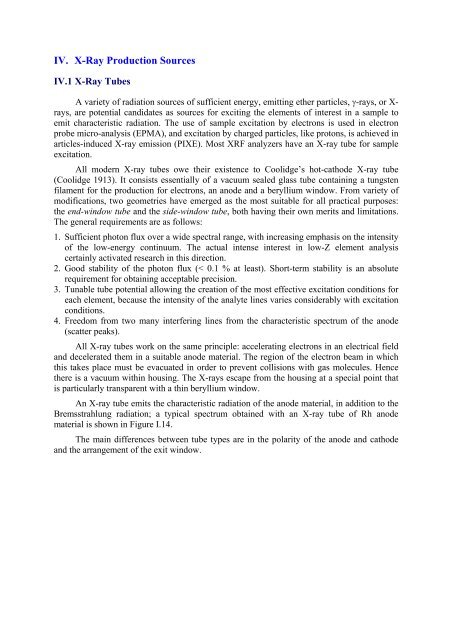X-Ray Fluorescence Analytical Techniques - CNSTN : Centre ...
X-Ray Fluorescence Analytical Techniques - CNSTN : Centre ...
X-Ray Fluorescence Analytical Techniques - CNSTN : Centre ...
You also want an ePaper? Increase the reach of your titles
YUMPU automatically turns print PDFs into web optimized ePapers that Google loves.
IV. X-<strong>Ray</strong> Production Sources<br />
IV.1 X-<strong>Ray</strong> Tubes<br />
A variety of radiation sources of sufficient energy, emitting ether particles, γ-rays, or Xrays,<br />
are potential candidates as sources for exciting the elements of interest in a sample to<br />
emit characteristic radiation. The use of sample excitation by electrons is used in electron<br />
probe micro-analysis (EPMA), and excitation by charged particles, like protons, is achieved in<br />
articles-induced X-ray emission (PIXE). Most XRF analyzers have an X-ray tube for sample<br />
excitation.<br />
All modern X-ray tubes owe their existence to Coolidge’s hot-cathode X-ray tube<br />
(Coolidge 1913). It consists essentially of a vacuum sealed glass tube containing a tungsten<br />
filament for the production for electrons, an anode and a beryllium window. From variety of<br />
modifications, two geometries have emerged as the most suitable for all practical purposes:<br />
the end-window tube and the side-window tube, both having their own merits and limitations.<br />
The general requirements are as follows:<br />
1. Sufficient photon flux over a wide spectral range, with increasing emphasis on the intensity<br />
of the low-energy continuum. The actual intense interest in low-Z element analysis<br />
certainly activated research in this direction.<br />
2. Good stability of the photon flux (< 0.1 % at least). Short-term stability is an absolute<br />
requirement for obtaining acceptable precision.<br />
3. Tunable tube potential allowing the creation of the most effective excitation conditions for<br />
each element, because the intensity of the analyte lines varies considerably with excitation<br />
conditions.<br />
4. Freedom from two many interfering lines from the characteristic spectrum of the anode<br />
(scatter peaks).<br />
All X-ray tubes work on the same principle: accelerating electrons in an electrical field<br />
and decelerated them in a suitable anode material. The region of the electron beam in which<br />
this takes place must be evacuated in order to prevent collisions with gas molecules. Hence<br />
there is a vacuum within housing. The X-rays escape from the housing at a special point that<br />
is particularly transparent with a thin beryllium window.<br />
An X-ray tube emits the characteristic radiation of the anode material, in addition to the<br />
Bremsstrahlung radiation; a typical spectrum obtained with an X-ray tube of Rh anode<br />
material is shown in Figure I.14.<br />
The main differences between tube types are in the polarity of the anode and cathode<br />
and the arrangement of the exit window.


